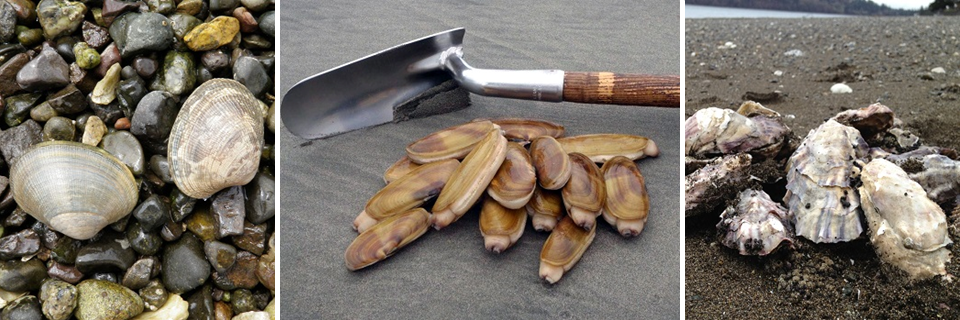Paralytic shellfish toxins (PSTs) are produced by some types of harmful algal blooms. Shellfish can accumulate these toxins, causing severe illness or death when people consume contaminated shellfish. A receptor binding assay can be used to test for paralytic shellfish toxins in mussels under the U.S. National Shellfish Sanitation Program. This project will expand the receptor binding assay (RBA) for PSTs to include other commercially relevant shellfish species, potentially replacing the mouse bioassay method currently used by the Washington State Public Health Laboratory and shellfish regulatory programs.
Why We Care
Paralytic shellfish toxins (PSTs) are potent neurotoxins that can accumulate in shellfish and cause paralytic shellfish poisoning (PSP), a severe type of food poisoning that results in illness or death. Commercial shellfish are routinely tested for PSTs using methods approved for regulatory use under the U.S. National Shellfish Sanitation Program (NSSP). Current NSSP-approved methods for PSTs include the mouse bioassay (MBA) for all shellfish species; post-column oxidation high performance liquid chromatography (PCOX-HPLC) for mussels, clams, oysters, and scallops; and a receptor binding assay (RBA) for mussels only. The RBA is a rapid, cost-effective test that does not use live mice exposed to PSTs like the MBA, and requires less costly instrumentation and less rigorous user expertise than the PCOX-HPLC method. The Sitka Tribe of Alaska’s Environmental Research Laboratory has used the RBA to monitor PSTs at community harvest sites in southeast Alaska shellfish since 2017, with no documented PSP illnesses at monitored harvest areas.
The limited application of the RBA for PSTs in additional shellfish species to date results from a lack of data. Validation studies in additional shellfish matrices will advance the RBA as a viable alternative regulatory method for testing PSTs in commercial shellfish under the NSSP. This project aims to expand the RBA method for PSTs to include more shellfish species, so the Washington State Public Health Laboratory and other state and Tribal shellfish programs can increase efficiency and reduce costs, while continuing to ensure safe shellfish for consumers.

What We Are Doing
The Washington State Department of Health will partner with the Sitka Tribe of Alaska and NOAA’s National Centers for Coastal Ocean Science (NCCOS) to conduct a series of shellfish matrix extension studies to expand the shellfish matrices that can be tested using the RBA for PSTs under the NSSP. Commercially available porcine receptors, a by-product of the pork industry, will be evaluated concurrently during the project as an alternative to the murine receptors used in the currently approved RBA method.
The objectives of the study are to:
- Build analytical capacity at Washington’s Department of Health by sharing established protocols and training from the Sitka Tribe of Alaska Environmental Research Laboratory and NCCOS for measuring PSTs using the RBA.
- Conduct matrix validation studies using clams, geoducks, oysters, razor clams, and mussels following the NSSP’s guidance for Laboratory Method Matrix Extensions.
- Develop and submit a proposal to the ISSC for evaluation and potential expansion of the RBA to additional shellfish matrices as an approved method under the NSSP.
- Inform and educate stakeholders and other state shellfish authorities about the project results and the benefits of using the RBA for PSTs.
Benefits of Our Work
Increasing the number of shellfish species that can be tested using the RBA for PSTs under the NSSP will allow regulatory laboratories to implement the RBA as an alternative to the MBA and PCOX-HPLC methods. Benefits of using the RBA over other NSSP-approved methods at the Washington State Public Health Laboratory and other state and Tribal shellfish programs include reducing shellfish testing costs, improving testing efficiency, and eliminating the use of mice for shellfish testing. The extensive validation studies conducted during this project will ensure that the RBA is comparable in rigor and performance to other methods that are currently used in shellfish safety regulatory programs under the NSSP.
Shelley Lankford of the Washington Department of Health leads this project. Other principal investigators include Jerry Borchert (Washington State Department of Health), Chris Whitehead (Sitka Tribe of Alaska), and Dr. Tod Leighfield (NOAA NCCOS). Collaborators include the Alaska Department of Environmental Conservation, Oregon Department of Agriculture, and Taylor Shellfish.
The project is funded through the NCCOS Prevention, Control, and Mitigation of Harmful Algal Blooms (PCMHAB) Program.
